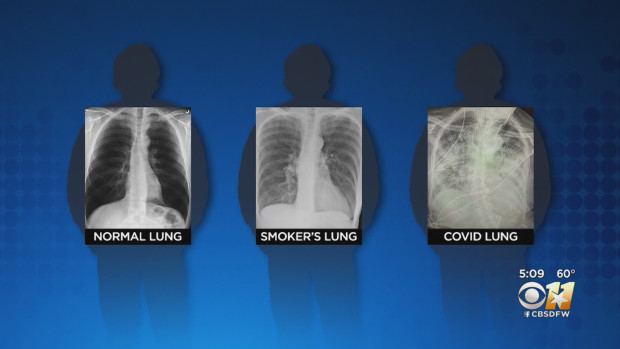COVID-19 damages the lungs more severely than long-term smoking
- Normal Liver Cells Found to Promote Cancer Metastasis to the Liver
- Nearly 80% Complete Remission: Breakthrough in ADC Anti-Tumor Treatment
- Vaccination Against Common Diseases May Prevent Dementia!
- New Alzheimer’s Disease (AD) Diagnosis and Staging Criteria
- Breakthrough in Alzheimer’s Disease: New Nasal Spray Halts Cognitive Decline by Targeting Toxic Protein
- Can the Tap Water at the Paris Olympics be Drunk Directly?
COVID-19 damages the lungs more severely than long-term smoking
COVID-19 damages the lungs more severely than long-term smoking. The new coronavirus damages the lungs more severely than long-term smoking and can cause lung scarring.
According to a report on the USA Today website, a doctor recently issued a group of chest X-ray images (hereinafter referred to as chest X-rays) of patients with new coronavirus pneumonia, smokers, and healthy people. It can be seen from the picture that the chest radiograph of patients with newcoronavirus pneumonia is more “white and cloudy” and the damage is heavier than long-term smoking.
Brittany Bankhead-Kendall, associate professor of surgery at Texas Tech University, wrote that a chest radiograph is like a black and white film. The bones, organs and muscles around the lungs of healthy people appear white, and the whole is mostly black. Various substances that can occupy the lung space, including fluids, lumps, tissue scars or other artifacts, will appear as white smoke based on their density, also known as “ground glass opacity.” Lung cancer, congestive heart failure, inflammatory lung disease, and usually viral pneumonia can all cause this symptom.
According to statistics, after the new coronavirus causes lung damage, about 50%-80% of patients’ chest radiographs can show “ground glass opacity.” According to existing clinical reports, there may be sustained damage for a long time after the illness of new coronavirus pneumonia. Some recovered people feel good about themselves without any problems, but the chest radiographs are often abnormal.
Kendall found that 70% to 80% of the asymptomatic infections of the n COVID-19 virus she collected showed abnormal chest radiographs, and every patient with COVID-19 pneumonia showed abnormalities. Comparing the chest radiographs of smokers and patients with new coronavirus pneumonia, it is found that the former is covered with scars and congested white threads, while the latter also has the same scar shape, and more in number, all over the lungs. The lung conditions of patients with new coronavirus pneumonia are even worse than some “old smokers”.
Kendall is not the first researcher to report long-term lung damage in patients with new coronavirus pneumonia. In July 2020, a report of 55 re-examination patients in The Lancet pointed out that more than 60% of people still have persistent respiratory symptoms three months after discharge, more than 70% have abnormal lung CT scans, and 25% People with decreased lung function.
In September 2020, a study of 82 survivors in the European Journal of Respiration pointed out that the new coronavirus may cause permanent lung damage, but there is hope of reversal. Studies have pointed out that the lung inflammation and fluid accumulation caused by the virus can be steadily improved within 12 weeks, proving that the lungs have an innate repair mechanism for scars. However, this study is small in scale and the average age of patients is about 50 years old. The results in large populations, especially elderly patients, require more evidence.
Kendall concluded: “We don’t know how long the impact of new coronavirus pneumonia on the body will last or whether it will eventually heal. But if you experience symptoms such as shortness of breath after recovery, please go to the hospital as soon as possible.”
(source:internet, reference only)
Disclaimer of medicaltrend.org




